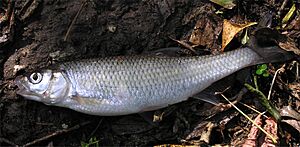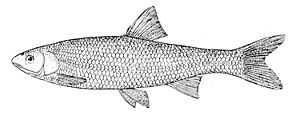Common dace facts for kids
Quick facts for kids Common dace |
|
|---|---|
 |
|
 |
|
| Conservation status | |
| Scientific classification | |
| Synonyms | |
|
The common dace (Leuciscus leuciscus) is a type of fish that lives in fresh water, like rivers and streams. Sometimes, it can even be found in slightly salty water near river mouths. This fish belongs to the Cyprinidae family, which includes carps and minnows. It's originally from Europe, but people have moved it to other parts of the world. Many people enjoy fishing for dace.
Contents
What Does the Common Dace Look Like?
The common dace has a sleek, silvery body covered in large scales. Its eyes have a yellowish color. The lateral line, a special line of scales along its side, usually has between 49 and 52 scales.
This fish has a mouth that points slightly downwards. Its upper jaw is a bit longer than its lower jaw. The tip of its upper lip lines up with the middle of its eye.
The dace has a caudal fin (tail fin) that is forked, like a "V" shape. Its anal fin (the fin on its belly near the tail) has a curved edge. The dorsal fin (on its back) has 2 to 3 stiff spines and 7 to 9 soft rays. The anal fin has 3 spines and 8 to 9 soft rays.
A common dace can grow up to about 30 centimetres (12 in) long.
Where Do Common Dace Live?
Common dace are naturally found across Europe and northern Asia. You can find them in rivers that flow into the North Sea, Baltic Sea, White Sea, and Barents Sea. They also live in rivers that empty into the Caspian Sea, like the Volga and Ural River.
In the Black Sea area, they are found in the Danube and Dnieper rivers. In France, they live in the Seine River and other rivers that flow into the Mediterranean Sea.
Sometimes, people have moved dace to new places where they didn't live before. For example, dace were brought to Ireland in the early 1900s. They were used as bait to catch bigger fish like pike.
When dace were introduced to Ireland, they sometimes lost their usual parasites. This can give them an advantage over fish that are native to that area.
Life in the Water: Habitat and Habits
Common dace prefer to live in rivers and streams. They can sometimes be found in lakes or in the slightly salty water near where rivers meet the sea. They are usually found swimming closer to the water's surface.
During winter, adult dace often gather in large groups, called shoals. They tend to stay in the slower parts of rivers or in quiet backwaters. Some adults might stay upstream in their spawning areas all winter.
When it's time to lay eggs, usually in March and April, dace swim upstream. They look for shallow areas with fast-flowing water and gravelly or stony bottoms. The female fish lay their pale yellow eggs, which stick to the gravel and stones.
Young dace, called juveniles, hide among roots and holes along the riverbanks. As they grow older, they move into faster-flowing water. The main food for common dace is small invertebrates, which are tiny creatures without backbones.
Fishing for Dace
The common dace is a popular fish for coarse anglers. These are people who fish for freshwater fish using a rod and line. The record for the largest dace caught in Britain with a rod weighed about 1.32 pounds (.599 kg).
In some parts of Europe, people eat dace, but it's not considered a very tasty fish. Dace are also often used as bait by anglers to catch larger fish. This is how they were likely introduced and spread in places like Ireland.
See also
- Fried dace with salted black beans, a dish made from a different type of dace.


